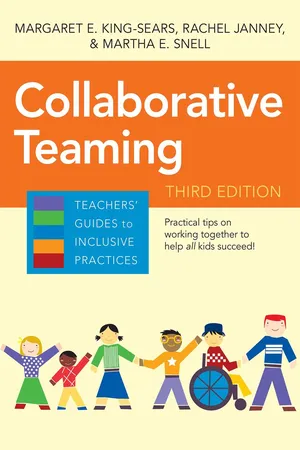
- 192 pages
- English
- ePUB (mobile friendly)
- Available on iOS & Android
Collaborative Teaming
About this book
Collaborative teaming is the glue that holds an inclusive school together. But most educators don't get explicit training on teamwork skills—and that's why you need the new third edition of this popular how-to book. Packed with practical tips, tools, and vignettes, Collaborative Teaming shows your staff how to work together effectively to support students with disabilities in inclusive classrooms. Perfect for independent study, inservice training, or preservice study, this reader-friendly guide will get teachers on board with collaborative teaming and give them fresh ways to improve the academic progress and behavior of all students.
LEARN HOW TO:
- Master multiple types of teaming, from co-teaching to collaborative consultation
- Clearly define a team's purpose and focus
- Establish trust and consistent communication among team members
- Schedule and facilitate productive team meetings
- Make sound decisions by consensus
- Solve problems and create action plans as a team
- Use teamwork to increase the participation and learning of all students
- Ensure positive interactions with families
PRACTICAL MATERIALS: Activities that help teachers reflect on and apply the strategies; vignettes that show strategies in action; reproducible forms and checklists for conducting meetings, co-teaching effectively, and more. (For easy printing, full-size forms will now be available for download when you purchase the book.)
WHAT'S NEW:
- How teaming relates to schoolwide initiatives like PBIS and RTI
- Expanded chapter on co-teaching
- New chapter on collaborative consultation
- More strategies for effective communication and conflict resolution
- Insights on using today's technology to collaborate
- New vignettes featuring diverse students with a wide range of disabilities
- Helpful "focusing questions" in each chapter—perfect for use in courses and book clubs
Frequently asked questions
- Essential is ideal for learners and professionals who enjoy exploring a wide range of subjects. Access the Essential Library with 800,000+ trusted titles and best-sellers across business, personal growth, and the humanities. Includes unlimited reading time and Standard Read Aloud voice.
- Complete: Perfect for advanced learners and researchers needing full, unrestricted access. Unlock 1.4M+ books across hundreds of subjects, including academic and specialized titles. The Complete Plan also includes advanced features like Premium Read Aloud and Research Assistant.
Please note we cannot support devices running on iOS 13 and Android 7 or earlier. Learn more about using the app.
Information
1
Overview of Collaborative Teaming
FOCUSING QUESTIONS
COLLABORATIVE TEAMS
Table of contents
- Cover
- Title Page
- Copyright Page
- Contents
- List of Figures
- List of Tables
- About the Forms
- About the Authors
- Acknowledgments
- Dedication
- 1. Overview of Collaborative Teaming
- 2. Building Team Structure
- 3. Learning Teamwork Skills
- 4. Problem Solving and Action Planning
- 5. Collaborative Consultation
- 6. Collaborative Teaching
- References
- Appendix A. Blank Forms
- Appendix B. Resources
- Index

